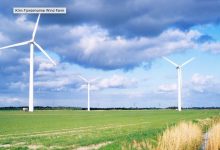The results of a multi-year scientific study in Denmark has concluded that birds are quite good at avoiding wind turbine blades, putting a serious dent in a common argument raised by anti-wind and -renewable activists.
The new study, carried out by three relevant consultancies for Swedish power company Vattenfall, investigated the area around 11 turbines every three days for three periods of just over a month in both the first and third years after the erection of the 67.2MW Klim Wind Farm in northern Jutland, Denmark (pictured above).
The research was carried out between August 2016 and May 2017 in the first year of operation, and August 2018 and May 2019 in the third year of operation. In an effort to determine an annual collision rate for the pink-footed geese and cranes, 11 selected turbines were inspected during autumn, winter, and spring.
The Klim Wind Farm is a valuable scientific opportunity, located in the immediate vicinity of the international Natura 2000 bird protection area Vejlerne, where each day, thousands of birds leave their roosting areas in Vejlerne to fly out to nearby fields to find food. Unsurprisingly, given its location, many of these birds fly past the Klim Wind Farm.
According to the study – the results of which will be published in DOF BirdLife Denmark’s scientific journal together with a ‘peer review’ for professional consolidation – in the first year of investigation, a total of 17 dead birds were found under the 11 selected wind turbines. In the third year, 22 dead birds or their remains were found.
Importantly, the discovered dead birds or remains were not always those of the pink-footed geese, and no dead cranes were found which had crashed into the turbines.
According to the final analysis, the researchers determined that the evasive response for both the pink-footed geese and the cranes over the two study years worked out to be 99.9% – based on a population of 20,000-30,000 geese and several hundred cranes.

Moreover, the report concluded that neither pink-footed geese nor cranes were found where it could be stated with absolute certainty that they had died as a result of a collision with the wind turbines. However, for the sake of prudence, the authors of the report assumed that all birds or remains of birds found under the turbines were a direct result of turbine collision.
“The area is an important natural area and quite extraordinary, as 20-30,000 pink-footed geese and several hundred cranes roost here,” said Jesper Kyed Larsen, Bioscience Lead at Vattenfall Environment & Sustainability.
“Thousands of birds fly past the wind farm in both the morning and the evening during the winter period, which is why it’s so positive to learn that the birds fly around or over the turbines to such a great extent. Hardly any of them hit the turbines, and the figure is considerably lower than previously believed.
“The results confirm that birds are astonishingly good at flying around or over the turbines. This is positive, not only because almost no birds die in collisions, but also because it means that the erection of wind turbines doesn’t need to be in direct conflict with natural areas. This new knowledge should be taken into consideration in connection with the planning of new wind farms.”
The report was carried out and authored by three recognised consultancies, including local professional ornithologists.
The three authors were Jan Drachmann of the Pennen & Sværdet consultancy, who has a Ph.D. in population biology (evolution, ecology and genetics) from Aarhus University; Simon Waagner of Profus Naturrådgivning (PROFUS Nature Advice), a candidatus scientiarum cand.scient graduate from Aarhus University; and Henrik Haaning Nielsen of Avifauna Consult, a professional ornithologist with lengthy resume of work.
Sponsored by Vattenfall, which naturally has a vested interest in the outcome of the report’s findings, the study was carried out partly to prove that the Klim Wind Farm complied with its environmental permit – which stipulates that collisions must not exceed 75% of the current sustainable mortality rates for populations of pink-footed geese and crane.
However, importantly, the findings stand for themselves, as do the credits of the three independent authors who carried out the investigation.







